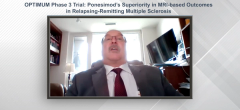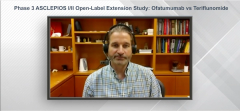
CLARITY Extension Trial: Disability Improvement With Cladribine
Episodes in this series

An overview of the CLARITY extension trial and the potential role for cladribine in disability improvement.
Bianca Weinstock-Guttman, MD: One interesting study presented at this meeting was evaluating the disability improvement in relapsing-remitting multiple sclerosis [MS] receiving cladribine tablets. Benefit was evaluated by the Expanded Disability Status Scale [EDSS]. The study is introducing a new way to evaluate and assess the improvement in the disability of MS patients. Previously, when we evaluated improvement in patients with MS, we included the incidence of change, so a decrease in EDSS score was 1 point, depending on the severity vs 5 points in a patient more disabled and maintained for 6 months. This new statistical evaluation is looking not only for the onset of improvement but also for the duration and maintenance of improvement.
This new statistical measure was applied to the CLARITY extension study that was an initial cladribine study of 2 years that compared cladribine treatment, 2 different dosages, with placebo. After 40 weeks of bridging, the patients were enrolled in the CLARITY extension study. Patients who were on placebo were started on cladribine, and patients that were previously on cladribine were divided on continuing the therapy versus placebo. That was an additional 2 years, so altogether with the bridging, it was 5 years at the end of the study.
The result of this study extension is comparing the baseline with 5 years later, so the primary outcome looked at the prevalence of improved EDSS between the 2 groups—the patients who initiated therapy from the beginning vs the ones who were initiated later on during the extension study. The results did show that patients who initiated the therapy from baseline compared with the ones later, had an improvement of 15% at 2 years vs 9% for the later group. This was pretty much maintained at 5 years, with the early group maintaining a 12.7% improvement vs 8.6%. At this time, the difference reached significance.
We would be very interested to measure not only how the patients are progressing but also how they are improving. Initially, the improvements were changing in the opposite direction than progression and maintaining for 6 months, but this time, the question comes up, “If the patient improved, is this improvement maintained? Or after 6 months, does it go away?” That this is very interesting and an important point, and it may bring us much more realistic information on patients’ status, if indeed improvement was maintained for 6 months or for a much longer period of time. The new statistical method looking for not only incidence but also the duration of improvement is important.
This study showed that starting the therapy early on—2 years before and even a little more with a bridge in between—has a higher chance to improve and maintain the improvement vs the 1 that started later on. Again, this new statistical method was applied for patients treated on cladribine.
The only concern I have on the early group of patients is that on the extension part, some of the patients were re-treated. In the early group of patients, half of them were receiving an additional 2 cladribine treatments while half were on placebo. It’s difficult to tease out if any of this improvement was in patients in the early group, in the patients who had additional treatment or in the ones who had only 2 initial treatments. But altogether, it’s supporting what we had before: patients initiating therapy also have less progression. This new study shows that they have a higher chance of improvement and maintaining improvement within at least 5 years than initiating therapy later on.
Newsletter
Keep your finger on the pulse of neurology—subscribe to NeurologyLive for expert interviews, new data, and breakthrough treatment updates.









































